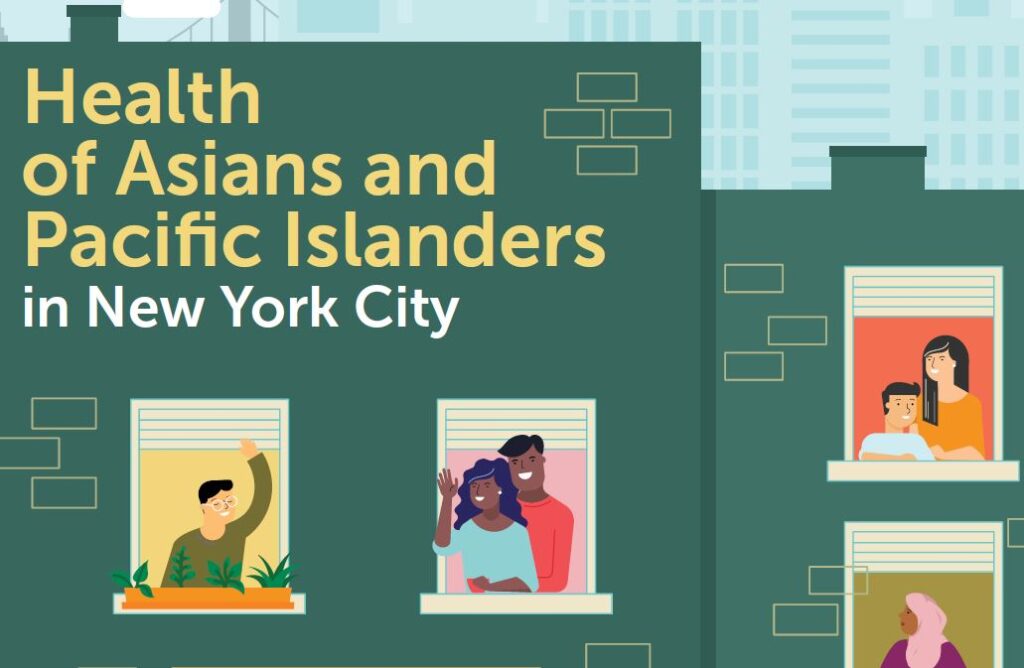Family, Government, Health, Resources
A closer look at Asian Americans covered by Medicaid / CHIP
While 1 in 4 Americans (24%) receive health coverage through Medicaid or the Children’s Health Insurance Program (CHIP), nearly 1 in 5 Asian Americans (17%, or approximately 3.6 million people) are enrolled in Medicaid or CHIP, accounting for about 5% of all Medicaid/CHIP participants. Although this is a smaller share relative to the general U.S. population, it still constitutes a significant portion of Asian Americans, with certain Asian subgroups relying disproportionately on Medicaid or CHIP for health coverage. Disaggregated SIPP data show higher participation rates among Asian boys, seniors, and adults with lower education. At every education level below a graduate degree, Asian adults are more likely than U.S. adults overall to be enrolled in Medicaid. After Congress passed the One Big Beautiful Bill Act on July 3, 2025, millions of Americans—including many Asian Americans—are expected to lose Medicaid and CHIP coverage due to program cuts, stricter work requirements, and more frequent eligibility reviews.

About 1 in 4 Americans receive health coverage through Medicaid or the Children’s Health Insurance Program (CHIP). These programs play a vital role in the U.S. healthcare system. Medicaid is a joint federal and state initiative that provides insurance for adults and children with limited income and resources, while CHIP extends health coverage to children in families whose incomes are too high to qualify for Medicaid but too low to afford private insurance.
As of March 2025, the The Centers for Medicare & Medicaid Services (CMS) reported 78.6 million people were enrolled in either Medicaid or CHIP, which includes 71.3 million on Medicaid and 7.3 million on CHIP. According to the U.S. Census Bureau Survey of Income and Program Participation (SIPP), 77.3 million Americans received coverage through these programs in 2022. SIPP provides detailed participant characteristics by race, ethnicity, age, sex, and education.
Demographic breakdown of Medicaid/CHIP participants
Racial and ethnic data from SIPP show White Americans, including those of Hispanic origin, are the largest recipients of Medicaid or CHIP at 67%, while Asian Americans and individuals of Some Other non-Hispanic race account for less than 10% of total participants. Non-Hispanic Black Americans account for 19%.
- 51.9 million or 67% of total Medicaid/CHIP participants are White. This group includes 32.4 million or 42% of non-Hispanic Whites and 19.5 million or 25% of White Hispanic* participants.
- 23.5 million or 30% are Hispanics of any race, the majority of whom identify as White.
- 14.6 million or 19% are non-Hispanic Black participants.
- 3.6 million or 5% are non-Hispanic Asian participants.
- 3.2 million or 4% identify as Some Other non-Hispanic race.
*Note: The U.S. Census defines White Hispanic as individuals who identify their race as White and their ethnicity as Hispanic or Latino. Pew Research has found that 58% of Hispanics identify as White when race and ethnicity are separated.
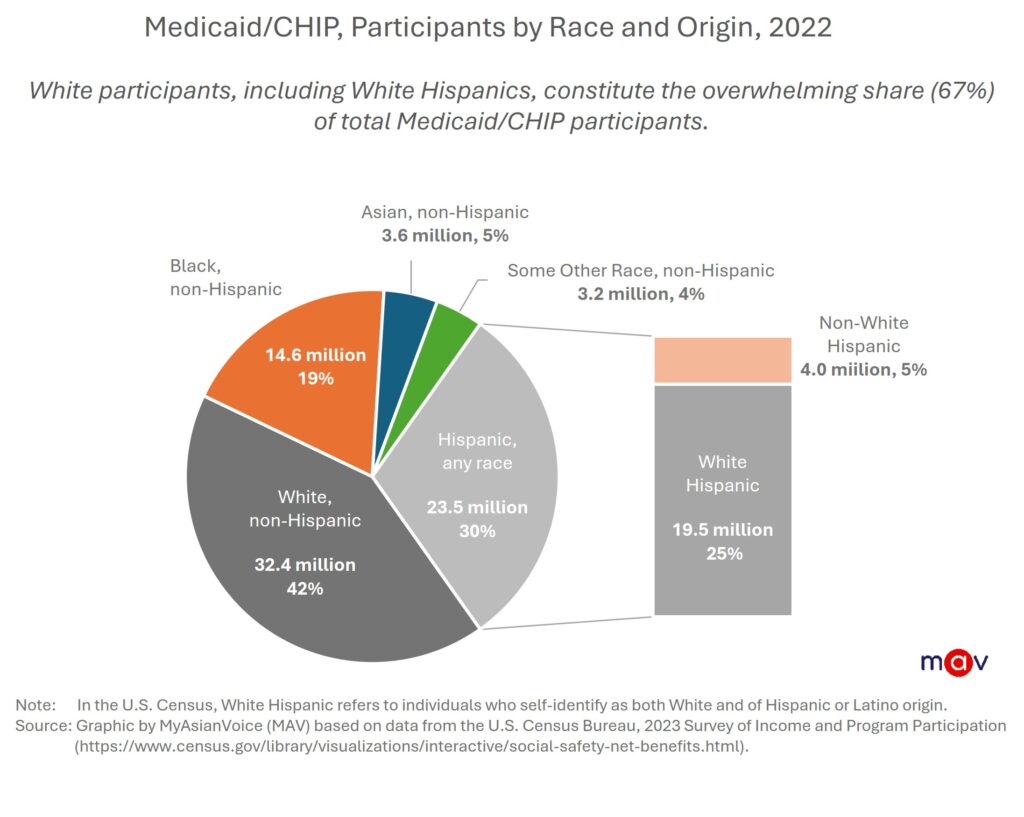
Medicaid/CHIP coverage by age and education
While the national coverage rate is 24%, certain groups rely more on Medicaid or CHIP for health coverage:
- 43% of all U.S. children are enrolled in Medicaid or CHIP.
- 41% of working-age adults with disabilities rely on Medicaid, compared to 20% of the overall working-age population.
- 63% of nursing home residents are covered by Medicaid, compared to only 13% of all seniors age 65 or older.
Medicaid participation varies by education level: individuals with lower education levels are more likely to be enrolled. For example, 40% of U.S. adults without a high school diploma depend on Medicaid, compared to just 5% of U.S. adults with advanced degrees.
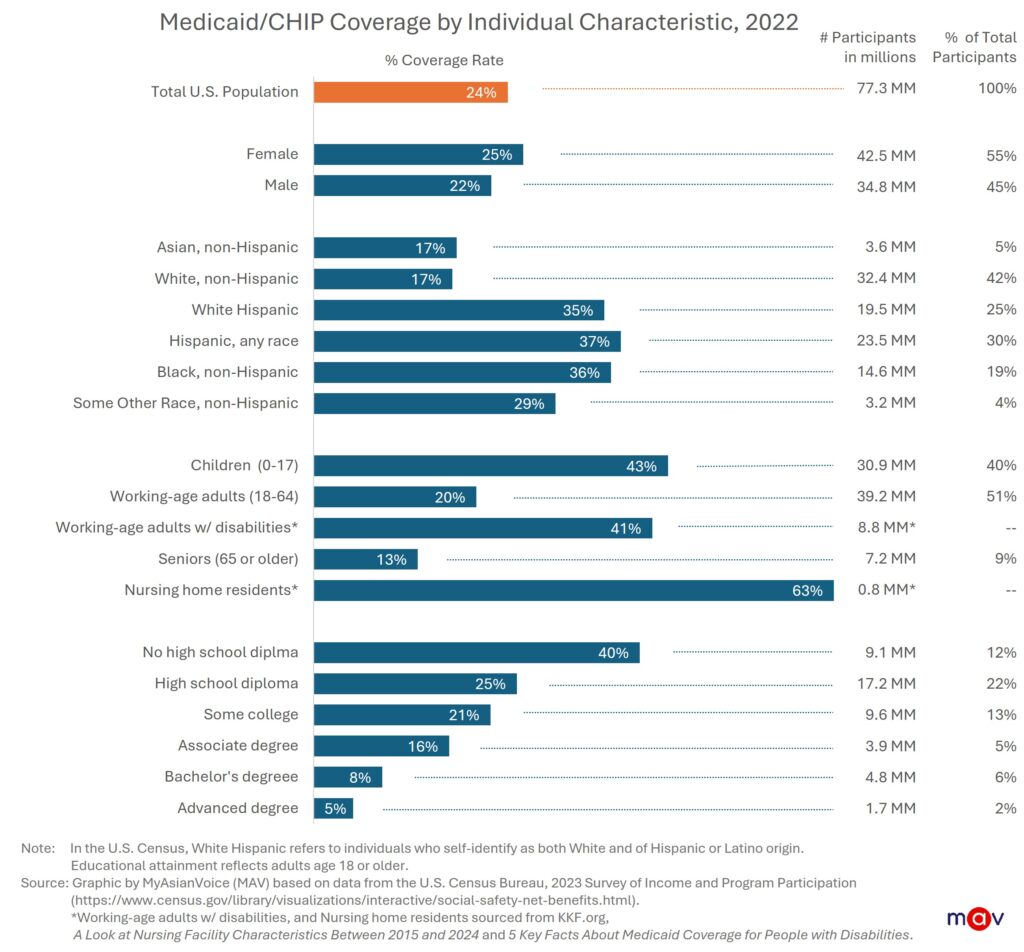
Nearly 1 in 5 Asian Americans rely on Medicaid or CHIP
Nearly 1 in 5 Asian Americans (17%, or approximately 3.6 million people) are enrolled in Medicaid or CHIP. Although this is a smaller share relative to the general U.S. population, it still constitutes a significant portion of Asian Americans, with certain Asian subgroups relying disproportionately on Medicaid or CHIP for health coverage.
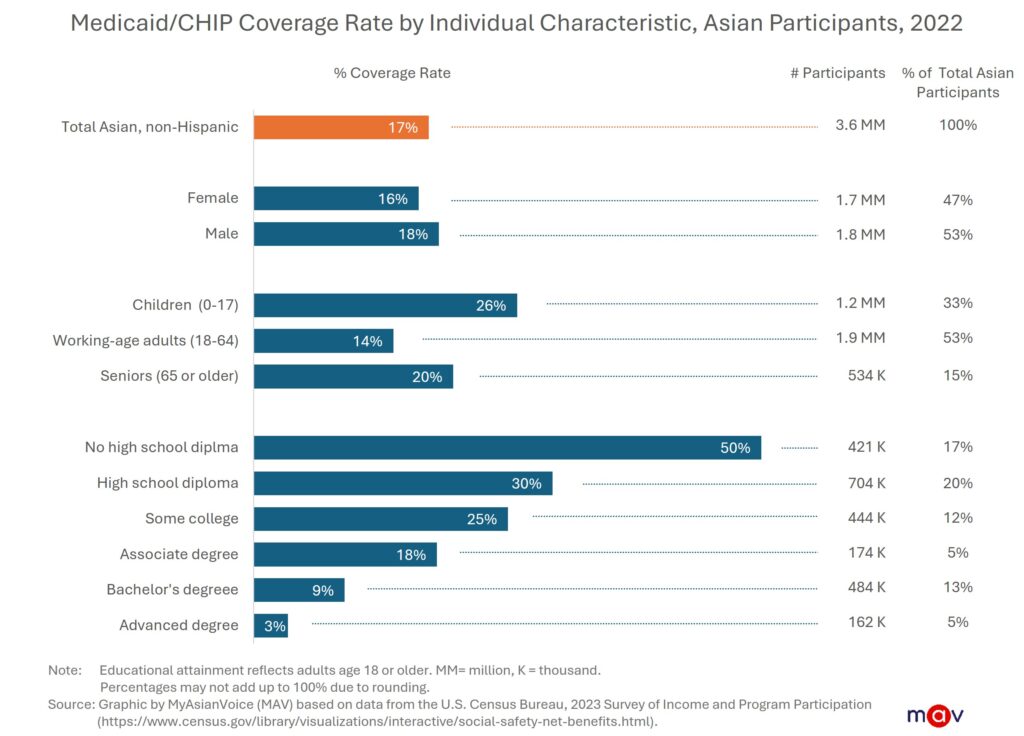
More Asian boys than girls rely on Medicaid or CHIP
Asian males are slightly more likely than Asian females to be enrolled (18% of Asian men vs. 16% of Asian women), driven largely by boys under 18. This is opposite of the national trend, where U.S. females are more likely than males to be enrolled (25% of women vs. 22% of men).
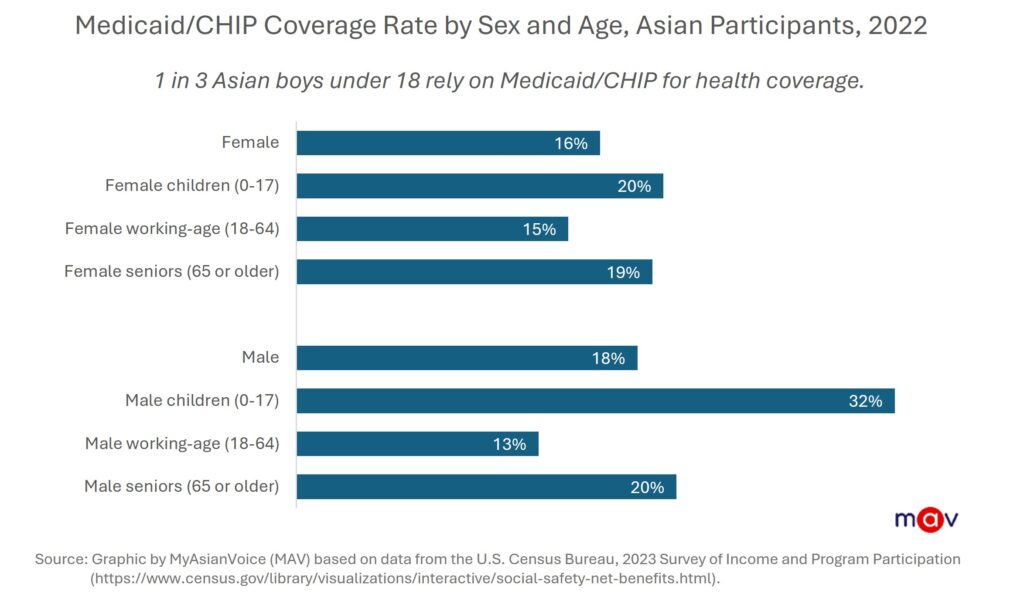
Asian adults with lower education rely more on Medicaid
At every education level below a graduate or advanced degree, Asian adults are more likely than U.S. adults overall to be enrolled in Medicaid. Notably, 50% of Asian adults without a high school diploma are covered by Medicaid, which is higher than both the national average of 40% and non-Hispanic White average at 34% for this group.
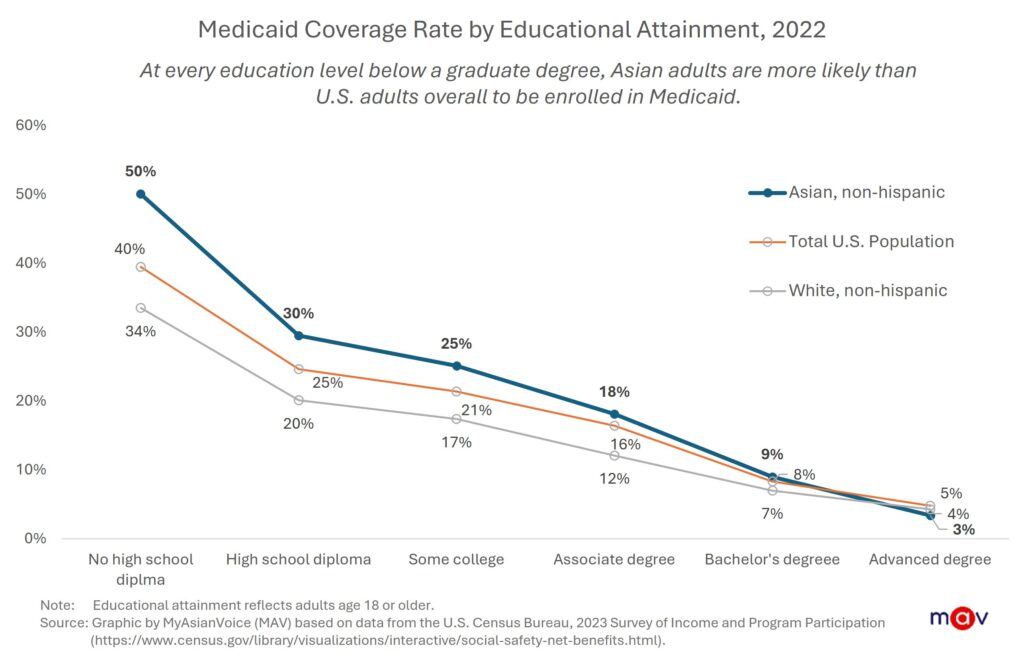
Asian seniors are more likely to rely on Medicaid
There is a bimodal pattern of Medicaid/CHIP enrollment among Asian Americans by age: children and seniors have higher enrollment rates than working-age adults. In particular, Asian seniors are more likely than the overall U.S. senior population to be enrolled in Medicaid.
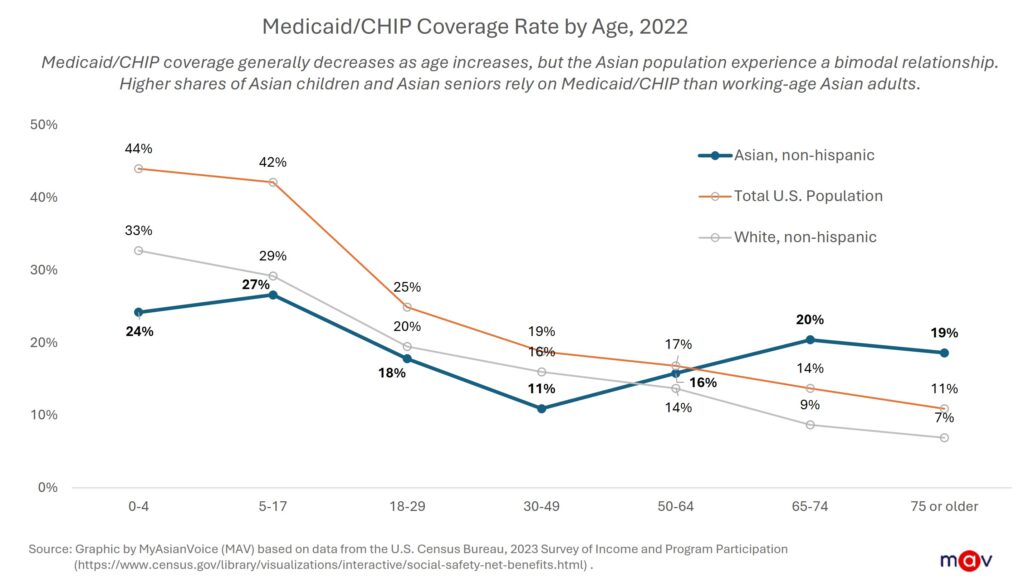
Medicaid spending and work status
Medicaid spending totaled $880 billion in 2023 according to KFF, formerly Kaiser Family Foundation. The federal government contributed $606 billion or 69% and U.S. states contributed the rest at $274 billion or 31%. Medicaid spending is not equally distributed among participants. Despite accounting for only 23% of Medicaid enrollees, seniors and people with disabilities account for 51% of all Medicaid spending, due to higher care needs and long-term services.
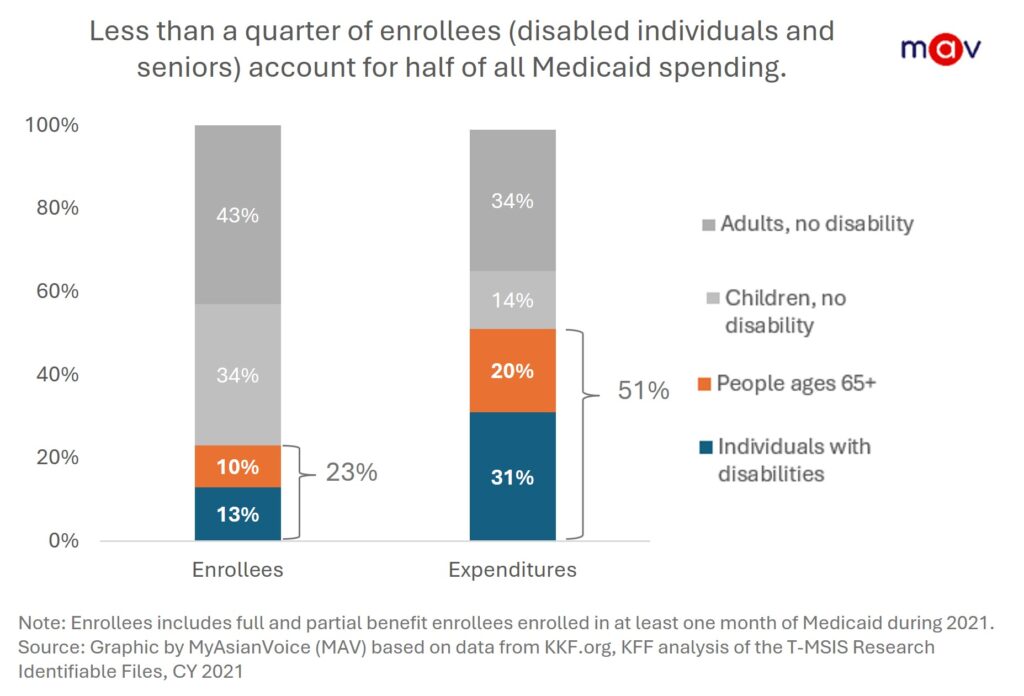
Among Medicaid participants who are working-age adults, 64% are employed—44% are working full-time and 20% are working part-time. Of the non-working adults, most are not working due to caregiving, sickness or disability, retirement, or are in school.
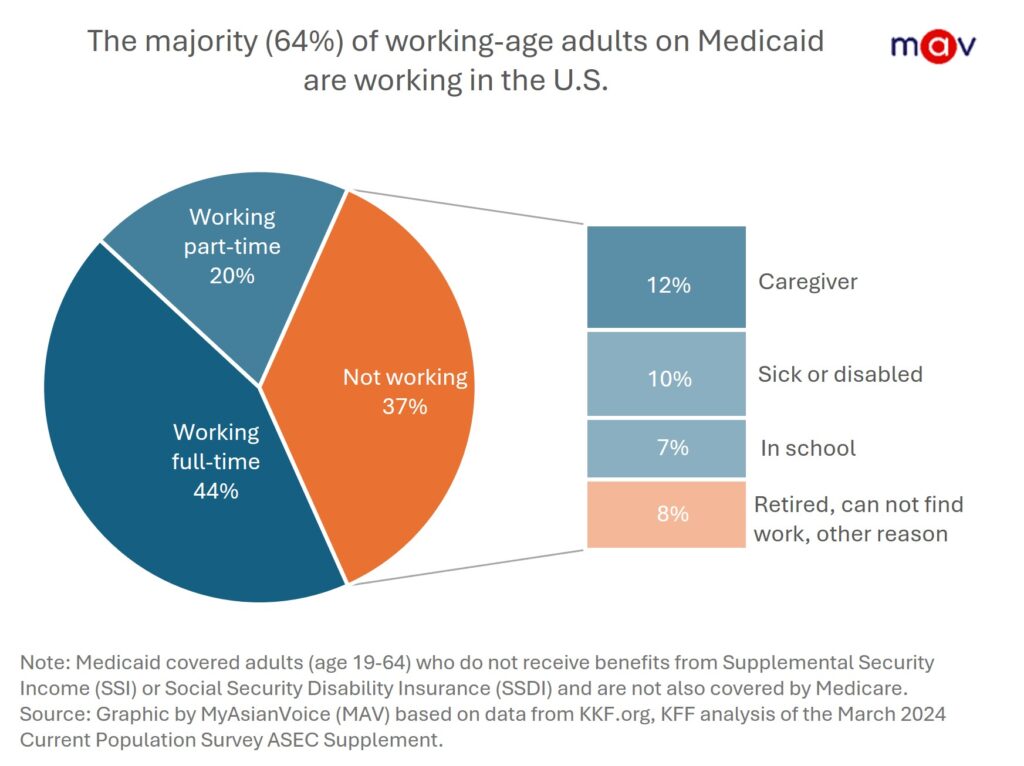
Medicaid/CHIP uncertain future
The Affordable Care Act (ACA) Medicaid expansion in 2014 produced substantial coverage gains among Asian Americans and all other racial and ethnic groups. From 2013 to 2022, over 20 million more Americans enrolled in Medicaid or CHIP, including 9.4 million non-Hispanic White, 4.3 million White Hispanic, 3.1 million non-Hispanic Black, and 0.9 million non-Hispanic Asian Americans. However, these gains are now at risk. After Congress passed the One Big Beautiful Bill Act on July 3, 2025, millions of Americans—including many Asian Americans—are expected to lose Medicaid/CHIP coverage due to program cuts, stricter work requirements, and more frequent eligibility reviews.
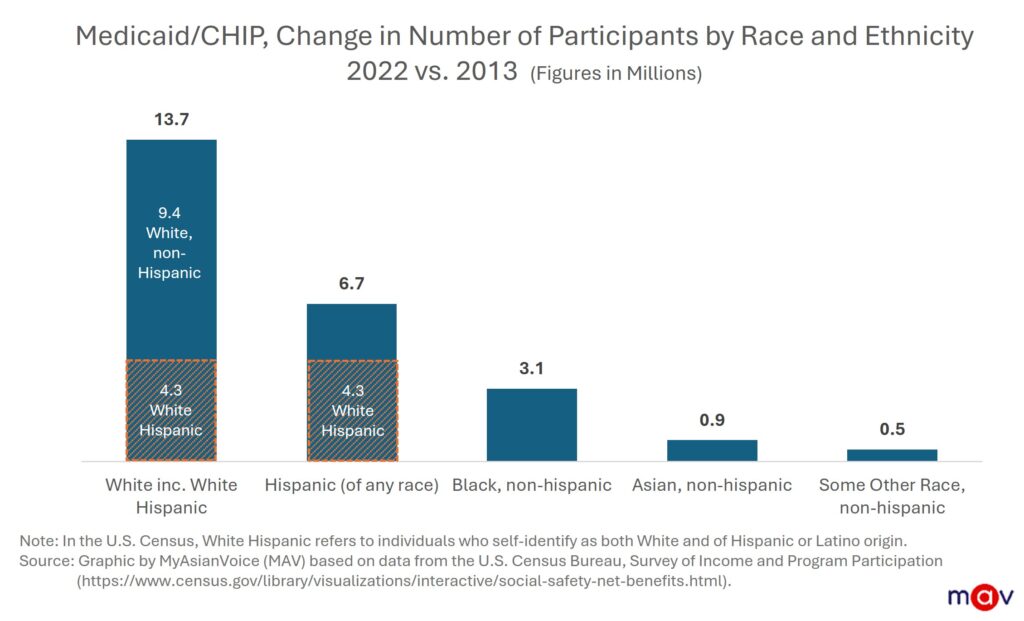
Helpful Resources
Who Is Receiving Social Safety Net Benefits? (U.S. Census Bureau interactive data visualizations)
March 2025 Medicaid & CHIP Enrollment Data Highlights (Centers for Medicare & Medicaid Services)
Medicaid (KKF, formerly Kaiser Family Foundation)
What the data says about Medicaid (Pew Research Center)
Get a monthly dose of our latest insights!


About
myasianvoice
At MyAsianVoice, we connect Asian Americans to surveys and research to bridge the Asian data gap.
Join our growing respondent list >>
